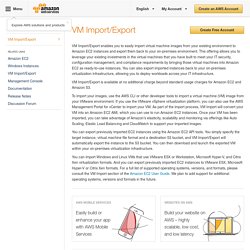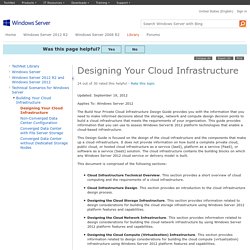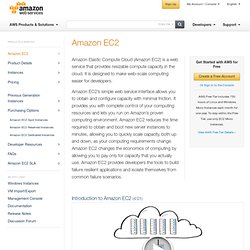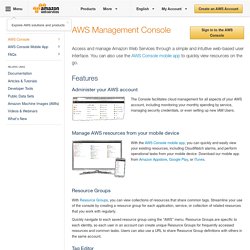

Home - Learn Amazon Web Services. Odoo. VM Import/Export. VM Import/Export enables you to easily import virtual machine images from your existing environment to Amazon EC2 instances and export them back to your on-premises environment.

This offering allows you to leverage your existing investments in the virtual machines that you have built to meet your IT security, configuration management, and compliance requirements by bringing those virtual machines into Amazon EC2 as ready-to-use instances. You can also export imported instances back to your on-premises virtualization infrastructure, allowing you to deploy workloads across your IT infrastructure. VM Import/Export is available at no additional charge beyond standard usage charges for Amazon EC2 and Amazon S3. To import your images, use the AWS CLI or other developer tools to import a virtual machine (VM) image from your VMware environment. If you use the VMware vSphere virtualization platform, you can also use the AWS Management Portal for vCenter to import your VM.
Compiere installation instructions edb. Amazon Elastic Cloud Compute. AWS Security Best Practices. Group Project(1) AWS_mediasharing.pdf. Designing Your Cloud Infrastructure. Many network architectures include a tiered design with three or more tiers such as core, distribution, and access.

Designs are driven by the port bandwidth and quantity required at the edge, in addition to the ability of the distribution and core tiers to provide higher speed uplinks to aggregate traffic. Additional considerations include Ethernet broadcast boundaries and limitations, spanning tree or other loop-avoidance technologies. A dedicated management network is a frequent feature of advanced data center virtualization solutions.
Most virtualization vendors recommend that hosts be managed via a dedicated network so that there is no competition with tenant traffic and to provide a degree of separation for security and ease of management purposes. This historically implied dedicating a network adapter per host and port per network device to the management network. Managing the network environment in a private cloud can present challenges that must be addressed. Openstack, AWS, HyperV, VMware. Who Uses These Cloud and Virtualization Systems?

OpenStack, AWS, Hyper-V and VMware are different services offering cloud computing or virtualization services. Let's take a closer look to see the advantages of each, as well as look at some companies using them. OpenStack OpenStack provides Infrastructure-as-a-Service (IaaS). It is a fast growing cloud computing project used by small and large companies alike. OpenStack is a cloud operating system consisting of several projects. Amazon Web Services (AWS) Odoo Essentials - Learn the basics on how to use Odoo 8 for your business. Amazon Elastic Compute Cloud (EC2) - Scalable Cloud Hosting. Amazon Elastic Compute Cloud (Amazon EC2) is a web service that provides resizable compute capacity in the cloud.

It is designed to make web-scale computing easier for developers. Amazon EC2’s simple web service interface allows you to obtain and configure capacity with minimal friction. It provides you with complete control of your computing resources and lets you run on Amazon’s proven computing environment. Amazon EC2 reduces the time required to obtain and boot new server instances to minutes, allowing you to quickly scale capacity, both up and down, as your computing requirements change. Amazon EC2 changes the economics of computing by allowing you to pay only for capacity that you actually use. Introduction to Amazon EC2 (4:01) Amazon EC2 enables you to increase or decrease capacity within minutes, not hours or days. You have complete control of your instances. You have the choice of multiple instance types, operating systems, and software packages.
AWS Management Console. With Resource Groups, you can view collections of resources that share common tags.

Streamline your use of the console by creating a resource group for each application, service, or collection of related resources that you work with regularly. Quickly navigate to each saved resource group using the “AWS” menu. Resource Groups are specific to each identity, so each user in an account can create unique Resource Groups for frequently accessed resources and common tasks. Users can also use a URL to share Resource Group definitions with others in the same account. Use the Tag Editor to easily manage tags for all resource types that support tags in any region. We are eager to hear about your user experience with the AWS Management Console. Application Management. Amazon Web Services (AWS) - Cloud Computing Services.